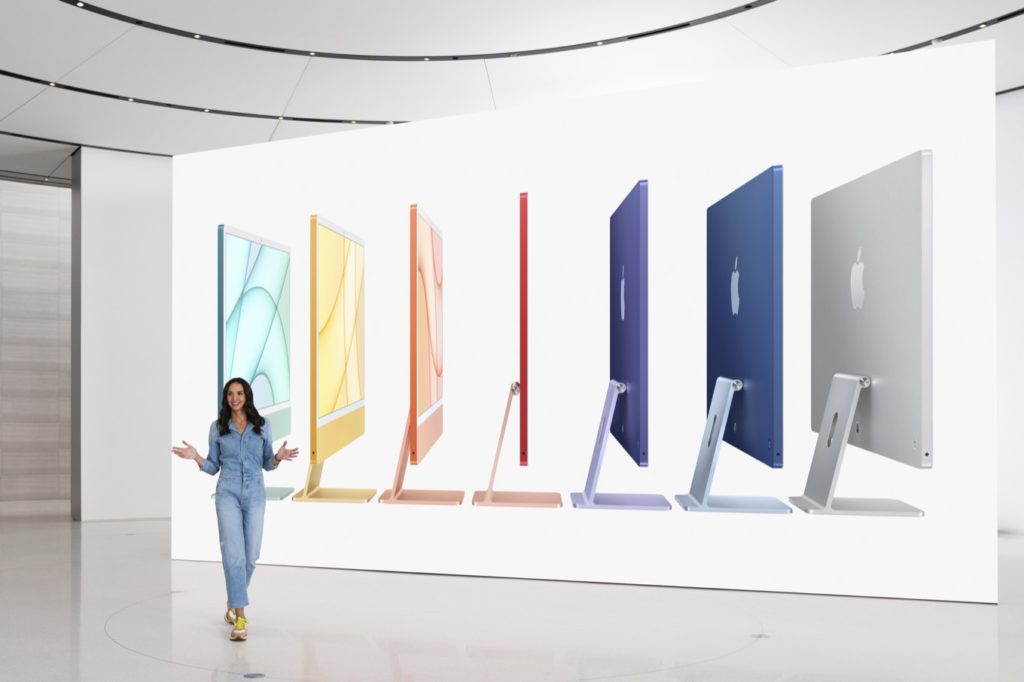The original iMac was all about colors. The first one was blindingly Bondi blue, and the follow-ups all came in various shades and designs. It was a computer you didn’t just buy to use, but to see.
When the G3 iMac left the scene, so did color. The iPod had taken the iMac’s lead and there were colorful iPod models for years, but the next generations of iMac were pale white plastic before shifting to silver aluminum. The Mac was drained of color, with an occasional darker gray or even more rarely, gold.
It’s been two decades since Apple rolled out a line of iMacs in an array of colors, but here we are: The new 24-inch M1 iMac has been announced, and it comes in what my Upgrade podcast pal Myke Hurley called “six colors and not a color.” Green, Yellow, Orange, Pink, Purple, Blue—all colors—and the supreme Apple not-a-color, Silver. One iMac, seven color options. What an embarrassment of riches.

Let’s do the accessory math:
- The $1299 base model is available in three colors and not a color—Blue, Green, Pink, and Silver. Those ship by default with a color-matched Magic Keyboard without Touch ID.
- The more expensive models are available in those six colors and not a color, and ship by default with a color-matched Magic Keyboard with Touch ID. (Buyers of the $1299 model can pay extra for this keyboard.)
- Buyers of either model can pay extra for the color-matched Magic Keyboard with Touch ID and Numeric Keyboard.
- Buyers of any model can get a color-matched Magic Mouse or, if they change their order, a color-matched Magic Trackpad.
Put it all together and that’s not just seven new iMac colors, it’s 18 keyboard variations and 14 pointing-device variations. While at launch Apple will only be providing the color-matched accessories with an iMac purchase, if history is any indication they will eventually be available for anyone to purchase. Given how many Apple Watch bands there are, Apple seems to have gotten very good at managing product inventory with a whole lot of variations. Good thing!

One hint that these accessories will ultimately be available for separate purchase: They work with other Macs. Specifically, the new Magic Keyboard models with Touch ID will work with any M1 Mac, not just the iMac. I suspect these devices will be with us for quite some time—and also I’d probably lay odds that these colors will be available on other Macs sometime soon. (Which, as someone who has been proposing more colorful Macs for years now, I’m really excited about! Bring on the orange MacBook Air.)
Speaking of color-matched accessories, let’s not forget the iMac’s new magnetic-attached power plug. While I don’t think this is validation for any rumors about a future return of MagSafe to Apple’s laptops, it does show that Apple has doubled down on magnets. First the back of the iPad Pro, then the MagSafe magnets on the iPhone 12, and now this.
In practical terms, the force required to yank the magnetic power cable off the iMac is the same force required to yank the current iMac’s plastic power plug out of its socket. So it seems unlikely that there will be a spate of disastrous iMac unpluggings laid at the feet of the choice to use magnets.

And of course, Apple will be making a lot of variations of the power cable, too. It’s color matched to the iMac—that’s seven different versions, all running to a white power brick that’s meant to be laid on the floor. That power brick also cleverly includes an Ethernet jack, so that’s one fewer cable that needs to snake across your desk and attach to the back of your iMac. I love the idea, and hope Apple explores a bit more functionality in this brick in the future. If I could plug a couple of USB devices into a hidden power brick instead of having to route them up to the back of my iMac on my desk, I’d love it.
I’d also like Apple to consider making some sort of extension cable or offering a version of the cable in longer lengths; two meters seems like a long distance, but it won’t reach the floor if my adjustable sit-stand desk is in its standing configuration. (Yes, I cut two meters of yarn and checked.)
In any event, Apple’s going to be making eleven variations of the brick, not seven. That’s because by default, the $1299 base model—three colors and not a color—don’t come with the clever power brick with included Ethernet. Their brick lacks Ethernet entirely. (You can pay extra to get the Ethernet-having brick.)
Like the M1 Macs introduced last fall, the iMac’s connectivity situation—we’re talking ports—is interesting. All M1 Macs offer exactly two full-on Thunderbolt ports—that’s clearly all they’re capable of offering. The M1 Mac Mini adds a couple of USB 3 ports with the old-school USB-A connector for added connectivity; the higher-end models of M1 iMac add two USB 3 ports with the new-school USB-C connector.

It’s a funny thing, because of course USB 4/Thunderbolt uses the USB-C connector too, so if users of the more-expensive iMac configurations have Thunderbolt devices, they will need to be sure to plug them into the ports with the lightning bolt symbol above them. Or they won’t work. (While it’s somewhat common on the PC side, it’s very unusual for Apple to place identical ports with different functionality differentiated only via labeling on a Mac.)
Thanks to the pandemic world we live in, I haven’t had a chance to get my hands on one of these new iMacs, but I’m looking forward to it. Apple’s photography of them is unsurprisingly gorgeous. Recent reports of colorful iMacs suggested that they’d be in soft, pastel colors like those found on the iPad Air—and those reports disappointed me, because I find the iPad Air’s colors to be way too restrained and, well, just not fun. Fortunately, those reports weren’t accurate—the backs and sides of these iMacs are bright and fun. The “chin” beneath the screen gets a softer color, which is probably understandable—you might not want a bright color in your face all the time. I’m also… not entirely sold on the white bezel around the display. Will it provide a pretty, neutral frame, or will it be distracting? I need to see one in person before making up my mind.
While I’m happy that Apple continues to offer a VESA-mountable version of the iMac, I’m disappointed (but unsurprised) that it continues to be sold separately, so once you order a VESA-mounted model it can’t be converted back to the normal stand. (Instead, you’d need to buy a VESA stand, and it certainly won’t be color matched.) But my bigger disappointment with the iMac stand is that its height is not adjustable. These gorgeous iMacs are going to go out in the world, and then people are going to have to stick old ratty dictionaries and encyclopedias under them in order to get them up to the right height. The Pro Display XDR stand is height adjustable—and while that stand costs almost as much as the low-end iMac, surely Apple could find some more affordable way to let iMac users take control of their ergonomics without sticking Roget’s Thesaurus and the AP Stylebook under their pretty new purple iMac. (I’m sure enterprising accessory companies are already planning their color-matched lines of aluminum iMac booster stands.)

In the good-news-bad-news department, the iMac now has a 1080p webcam! Combined with the image processing on the M1 chip, I can see why Apple would claim that the new iMac camera is the best camera ever on a Mac. But that’s a looooooooow bar. Meanwhile, on the iPad side, Apple’s added an ultrawide camera with some clever machine-learning-based software to dynamically zoom and pan around the image to keep you in frame. Sounds great, but like Face ID, it’s the sort of feature that would be perfect on the iMac, but… isn’t. Apple’s commitment to the Mac has really come back these past few years, and the transition to Apple-designed processors is going to lead to great things, but the fact that this new webcam is being trumpeted as the best ever just shows you how far behind the Mac is in some areas.
I’m also looking forward to trying one of these iMacs because Apple claims they’ve got great speakers and “studio quality” microphones. Apple’s been making claims like this for a while now regarding their laptops, and while I see where they’re coming from, I think they’re prone to exaggeration. The microphones in Apple’s laptops have gotten a lot better, and they use multiple mics and beam forming to do some algorithmic noise cancellation that results in cleaner input. I don’t think “studio quality” is a phrase that should ever be attributed to them, because that sets a bar they can’t clear (unless, I suppose, you took them into a studio environment and recorded with them there), but built-in computer microphones are generally awful and yet people rely on on them, so they should be much better. And Apple’s newer ones are. I assume that’s the case of the new iMac, which will be great news for every person who gets on a Zoom call with someone using one of them.
As for the speakers, well… my iMac Pro is plugged in to an external speaker. Occasionally I’ll end up playing audio through my iMac’s speaker, and it’s always better than I expect it to be—but also not nearly as good as the external speaker on my desk. So when Apple says the M1 iMac’s speakers are much better, and can even do impressive spatial-audio effects, I’m intrigued and want to hear them in person. What I really want is a set of speakers that’s good enough for me to stop parking an external speaker on my desk, but that feels unlikely. I’d love to be proven wrong, though.
If you appreciate articles like this one, support us by becoming a Six Colors subscriber. Subscribers get access to an exclusive podcast, members-only stories, and a special community.

